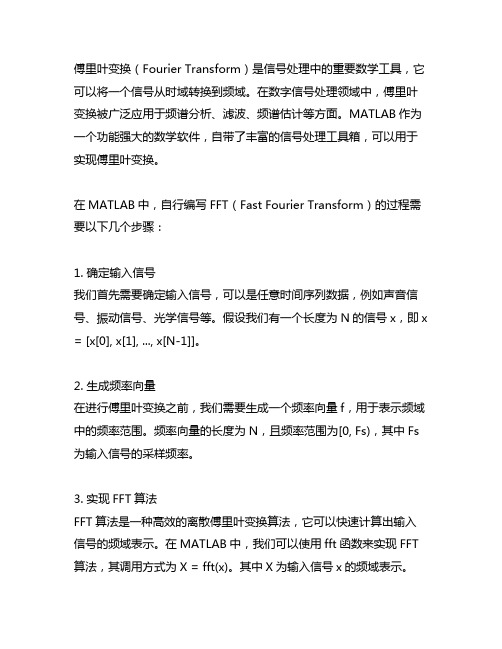傅里叶变换matlab程序
- 格式:doc
- 大小:21.40 KB
- 文档页数:3

傅里叶变换(Fourier Transform)是信号处理中的重要数学工具,它可以将一个信号从时域转换到频域。
在数字信号处理领域中,傅里叶变换被广泛应用于频谱分析、滤波、频谱估计等方面。
MATLAB作为一个功能强大的数学软件,自带了丰富的信号处理工具箱,可以用于实现傅里叶变换。
在MATLAB中,自行编写FFT(Fast Fourier Transform)的过程需要以下几个步骤:1. 确定输入信号我们首先需要确定输入信号,可以是任意时间序列数据,例如声音信号、振动信号、光学信号等。
假设我们有一个长度为N的信号x,即x = [x[0], x[1], ..., x[N-1]]。
2. 生成频率向量在进行傅里叶变换之前,我们需要生成一个频率向量f,用于表示频域中的频率范围。
频率向量的长度为N,且频率范围为[0, Fs),其中Fs 为输入信号的采样频率。
3. 实现FFT算法FFT算法是一种高效的离散傅里叶变换算法,它可以快速计算出输入信号的频域表示。
在MATLAB中,我们可以使用fft函数来实现FFT 算法,其调用方式为X = fft(x)。
其中X为输入信号x的频域表示。
4. 计算频谱通过FFT算法得到的频域表示X是一个复数数组,我们可以计算其幅度谱和相位谱。
幅度谱表示频率成分的强弱,可以通过abs(X)得到;相位谱表示不同频率成分之间的相位差,可以通过angle(X)得到。
5. 绘制结果我们可以将输入信号的时域波形和频域表示进行可视化。
在MATLAB 中,我们可以使用plot函数来绘制时域波形或频谱图。
通过以上几个步骤,我们就可以在MATLAB中自行编写FFT傅里叶变换的算法。
通过对信号的时域和频域表示进行分析,我们可以更好地理解信号的特性,从而在实际应用中进行更精确的信号处理和分析。
6. 频谱分析借助自行编写的FFT傅里叶变换算法,我们可以对信号进行频谱分析。
频谱分析是一种非常重要的信号处理技术,可以帮助我们了解信号中所包含的各种频率成分以及它们在信号中的能量分布情况。

如何在MATLAB中进行傅里叶变换傅里叶变换是一种常见的信号处理技术,可以分析信号的频域特征。
在MATLAB中,傅里叶变换可以通过内置的函数来实现。
本文将具体介绍如何在MATLAB中进行傅里叶变换,包括基本概念、函数的使用方法、应用示例等。
一、基本概念傅里叶变换是将一个信号从时域转换为频域的方法。
它可以将一个复杂的信号表示为一系列简单的正弦和余弦函数的叠加。
傅里叶变换的目的是通过将信号分解成不同频率的分量,来揭示信号的频谱特性,从而方便后续的处理和分析。
傅里叶变换有两种形式:离散傅里叶变换(Discrete Fourier Transform, DFT)和快速傅里叶变换(Fast Fourier Transform, FFT)。
DFT可以用于任意长度的离散信号,而FFT是DFT的一种高效实现方法,适用于长度为2的幂次的离散信号。
二、MATLAB中的傅里叶变换函数MATLAB提供了多个用于傅里叶变换的函数,其中最常用的是fft和ifft函数。
fft函数用于计算信号的快速傅里叶变换,ifft函数用于计算信号的快速傅里叶逆变换。
要使用这些函数进行傅里叶变换,首先需要将信号转化为MATLAB中的向量形式。
可以使用MATLAB提供的norm函数将信号规范化为向量形式,或自己将信号转换为向量。
接下来,可以直接调用fft函数计算信号的傅里叶变换,或者调用ifft函数计算信号的傅里叶逆变换。
三、傅里叶变换的应用示例傅里叶变换在信号处理领域有着广泛的应用,以下是一个简单的应用示例:使用傅里叶变换对一个声音信号进行频谱分析。
首先,我们需要加载一个声音文件到MATLAB中。
可以使用MATLAB提供的audioread函数读取声音文件,该函数会返回声音信号的采样率和声音数据。
接下来,可以通过调用fft函数对声音信号进行傅里叶变换。
假设我们已经将声音信号保存在名为"sound.wav"的文件中,可以使用以下代码进行声音信号的傅里叶变换:```[sound_data, sample_rate] = audioread('sound.wav');sound_fft = fft(sound_data);```在对声音信号进行傅里叶变换之后,我们可以通过计算傅里叶变换结果的幅度谱和相位谱来获取信号的频域特征。

一、引言Matlab是一款功能强大的数学软件,可以进行多种数学运算和数据可视化处理。
其中,绘制方波并进行傅里叶变换是其常用的功能之一。
本文将介绍如何使用Matlab绘制方波并进行傅里叶变换的代码。
二、绘制方波1. 打开Matlab软件,创建一个新的脚本文件。
2. 输入以下代码用于绘制方波:```matlabt = linspace(0, 1, 1000); 生成时间序列f = square(2*pi*5*t); 生成频率为5Hz的方波plot(t, f); 绘制方波图形xlabel('Time (s)'); X轴标签ylabel('Amplitude'); Y轴标签title('Square Wave'); 图形标题```3. 运行代码,即可在Matlab中看到绘制的方波图形。
三、进行傅里叶变换1. 接下来,我们将对绘制的方波进行傅里叶变换。
2. 输入以下代码进行傅里叶变换:```matlabL = length(t); 信号的长度N = 2^nextpow2(L); 计算最近的2的幂Y = fft(f, N)/L; 进行傅里叶变换frequencies = 1/(2*1)*linspace(0,1,N/2); 计算频率amplitude = 2*abs(Y(1:N/2)); 计算幅值plot(frequencies, amplitude); 绘制傅里叶变换图形xlabel('Frequency (Hz)'); X轴标签ylabel('Amplitude'); Y轴标签title('Fourier Transform of Square Wave'); 图形标题```3. 运行代码,即可在Matlab中看到绘制的傅里叶变换图形。
四、总结通过以上步骤,我们成功地使用Matlab绘制了方波并进行了傅里叶变换。

matlab自己写傅里叶变换程序傅里叶变换是一种重要的数学工具,广泛应用于信号处理、图像处理、通信等领域。
它可以将一个信号在频域和时域之间进行转换,帮助我们理解信号的频谱特性。
在本文中,我将介绍如何使用Matlab编写傅里叶变换程序,以及一些相关的应用。
我们需要明确傅里叶变换的定义和公式。
傅里叶变换可以将一个连续时间的信号分解为多个不同频率的正弦和余弦函数的叠加。
在Matlab中,可以使用fft函数进行傅里叶变换。
具体步骤如下:1. 准备信号数据:首先,我们需要准备一个信号数据。
这可以是一个连续时间的信号,也可以是一个离散时间的信号。
可以通过输入一组数据来表示信号。
2. 进行傅里叶变换:使用fft函数对信号进行傅里叶变换。
该函数会返回一个复数数组,表示信号在频域中的幅度和相位信息。
3. 绘制频谱图:使用plot函数将频域信息绘制成频谱图。
这可以帮助我们直观地理解信号的频率分布情况。
4. 反变换:如果需要将傅里叶变换后的频域信号重新转换回时域信号,可以使用ifft函数进行反变换。
除了基本的傅里叶变换,Matlab还提供了一些相关的函数和工具箱,例如快速傅里叶变换(FFT)、离散傅里叶变换(DFT)、傅里叶级数等。
这些工具可以帮助我们更方便地处理和分析信号。
傅里叶变换在信号处理中有着广泛的应用。
例如,我们可以使用傅里叶变换对音频信号进行频谱分析,以便了解音频中各个频率分量的贡献。
另外,傅里叶变换还可以用于图像处理,例如图像压缩和滤波等方面。
总结起来,Matlab提供了丰富的函数和工具箱,可以帮助我们进行傅里叶变换及相关的信号处理任务。
通过编写傅里叶变换程序,我们可以更好地理解信号在频域和时域之间的转换关系,以及信号的频谱特性。
这对于许多科学研究和工程应用都具有重要意义。

matlab如何做傅里叶变换# MATLAB中的傅里叶变换详解## 引言傅里叶变换是一种在信号处理和频谱分析中广泛应用的数学工具。
在MATLAB中,通过简单的命令就可以进行傅里叶变换,这使得信号处理变得更加便捷。
本文将详细介绍MATLAB中如何进行傅里叶变换,包括基本概念、函数调用和实际案例。
## 傅里叶变换的基本概念傅里叶变换是一种将信号从时域转换到频域的方法,它将信号表示为不同频率的正弦和余弦函数的组合。
在MATLAB中,我们可以使用傅里叶变换来分析信号的频谱特性,了解信号中包含的不同频率分量。
## MATLAB中的傅里叶变换函数在MATLAB中,执行傅里叶变换的主要函数是`fft`(快速傅里叶变换)。
以下是基本的语法格式:```matlabY = fft(X)```其中,X是输入信号,Y是傅里叶变换后得到的频谱。
这是最简单的用法,但在实际应用中,我们通常需要更多的控制和信息。
## 单边和双边频谱傅里叶变换得到的频谱通常是双边频谱,即包含正频率和负频率。
在实际应用中,我们更关心的可能是单边频谱,只包含正频率部分。
在MATLAB中,可以使用`fftshift`函数和`ifftshift`函数来实现频谱的移动。
```matlabY_shifted = fftshift(Y);```上述代码将得到的频谱Y进行频谱移动,使得正频率部分位于中心。
如果需要还原为原始频谱,可以使用`ifftshift`函数。
## 频谱可视化为了更直观地了解信号的频谱特性,我们通常使用图形来展示。
在MATLAB中,可以使用`plot`函数来绘制频谱图,同时配合使用`fftshift`等函数来处理频谱数据。
```matlabFs = 1000; % 采样频率T = 1/Fs; % 采样间隔L = 1000; % 信号长度t = (0:L-1)*T; % 时间向量X = 0.7*sin(2*pi*50*t) + sin(2*pi*120*t); % 生成信号Y = fft(X); % 进行傅里叶变换f = Fs*(0:(L/2))/L; % 计算频率plot(f, abs(Y(1:L/2+1))); % 绘制单边频谱图xlabel('频率 (Hz)');ylabel('|Y(f)|');```上述代码生成了一个包含两个正弦波的信号,并绘制了其单边频谱图。

Fs = 1000;% Sampling frequency采样频率T = 1/Fs; % Sample time采样周期L = 1000;% Length of signal信号长度(点的个数)t = (0:L—1)*T; %Time vector时间向量(序列)(用来画图)% Sum of a 50 Hz sinusoid and a 120 Hz sinusoid一个50赫兹正弦加上120赫兹正弦x = 0。
7*sin(2*pi*50*t) + sin(2*pi*120*t);y = x + 2*randn(size(t)); % Sinusoids plus noise正弦之和加上正态噪声figure(1);plot(Fs*t(1:50),y(1:50))title('Signal Corrupted with Zero-Mean Random Noise’)%被零均值噪声祸害的信号xlabel('time (milliseconds)')%It is difficult to identify the frequency components by looking at the original signal。
Converting to the frequency domain, the discrete Fourier transform of the noisy signal y is found by taking the fast Fourier transform (FFT):%从时域上直接看原信号难以确定各频率分量. 通过使用快速傅里叶变换FFT,实现了含噪声信号Y的离散傅里叶变换,从而把信号转换到频域上(确定频率分量)NFFT = 2^nextpow2(L); % Next power of 2 from length of yY = fft(y,NFFT)/L;f = Fs/2*linspace(0,1,NFFT/2+1);% Plot single—sided amplitude spectrum.figure(2);plot(f,2*abs(Y(1:NFFT/2+1)))title('Single-Sided Amplitude Spectrum of y(t)')xlabel('Frequency (Hz)’)ylabel('|Y(f)|')A=xlsread('SHUJU2。
matlab对给定坐标点求傅里叶变换一、概述傅里叶变换是信号处理中常用的一种方法,用于将时域上的信号转换到频域上。
在数字信号处理中,matlab是一种常用的工具,能够方便地对给定的坐标点进行傅里叶变换。
本文将介绍如何使用matlab对给定坐标点进行傅里叶变换,包括输入数据处理、变换函数的调用和输出结果的解释等。
二、数据准备1. 将给定的坐标点存储为matlab中的向量或矩阵,其中横坐标和纵坐标分别对应向量的两个分量。
将(1,2)、(2,3)、(3,4)三个点存储为:x = [1 2 3];y = [2 3 4];2. 确保输入数据的采样间隔是均匀的,如果不均匀需要进行插值处理。
三、傅里叶变换的调用在matlab中,使用fft函数可以对给定的坐标点进行傅里叶变换。
在调用该函数时,需要指定采样频率,傅里叶变换的结果将与采样频率相关联。
以下为对给定坐标点进行傅里叶变换的示例代码:fs = 1000; 采样频率N = length(x); 采样点数X = fft(y, N)/N; 对y进行傅里叶变换f = (0:N-1)*(fs/N); 频率坐标amplitude = abs(X); 幅值phase = angle(X); 相位四、结果解释1. 频率坐标f是通过采样频率和采样点数计算得到的,表示了傅里叶变换结果的频率范围。
2. 幅值amplitude表示傅里叶变换结果的振幅大小,可用于分析频域上不同频率的能量分布情况。
3. 相位phase表示了傅里叶变换结果的相位信息,对于描述信号的相位特性具有重要意义。
五、结果可视化通过matlab的绘图函数,可以将傅里叶变换的结果进行可视化展示,以便更直观地分析频域上的信息。
以下为将傅里叶变换的结果可视化的示例代码:subplot(2,1,1);stem(f, amplitude); 绘制频谱图xlabel('Frequency (Hz)'); ylabel('Amplitude');title('Amplitude Spectrum');subplot(2,1,2);stem(f, phase); 绘制相位谱图xlabel('Frequency (Hz)'); ylabel('Phase (radians)');title('Phase Spectrum');六、总结本文介绍了如何使用matlab对给定坐标点进行傅里叶变换的方法,包括数据准备、变换函数的调用和结果的解释与可视化。
matlab如何做傅里叶变换
MATLAB 是一种用于数学建模和计算的高级编程语言,它拥有丰富的图形处理、计算和可视化工具,可以为用户提供强大的思维创新和简化研究的方法。
傅里叶变换 (FFT) 是一种快速的数学处理方法,可以用来将信号和系统的时间域表示转换为频率域中的表示。
MATLAB 具有内置函数,可帮助用户执行傅里叶变换,从而为用户提供了非常方便的使用方式。
首先,使用 MATLAB 中的 fft 函数可以进行傅立叶变换。
由于傅里叶变换是一种离散变换,因此在使用过程中,需要考虑计算时的采样频率等问题,使用如下语句可以实现:y = fft(x,n)。
其中,x 表示要进行变换的原始信号,n 表示要进行傅里叶变换的长度,默认的n 为原始信号的长度。
此外,MATLAB 还提供了另一个相关的函数 ifft,用于进行逆变换。
它的函数形式与前文所述的进行正向变换的函数非常类似,如下所示:ifft(x,n),其中 x 表示要逆变换的存储在矢量中的信号,n 表示要进行反变换的长度,默认的 n 为 x 的长度。
此外,MATLAB 还提供了另一个函数 fftshift,它主要用于移动傅里叶变换的中心位置,并调整频域的形状,因此可以有效地提高频谱的准确性。
最后,MATLAB 还提供了多种其他的傅里叶变换相关的相关函数,例如 fft2 用于二维离散时间信号的变换,fft3 用于三维离散时间信号的变换,以及 rofft、gofft 等形式的实数和复数形式的变换等。
因此,MATLAB 具有可扩展性强的特点,可以为不同的傅立叶变换应用场景提供支持。
matlab实现傅里叶变换与反变换、离散余弦变换与反变换首先,我们需要了解傅里叶变换和离散余弦变换的原理。
傅里叶变换是一种将时域信号转换为频域信号的方法,它可以将任意信号分解为一系列正弦和余弦信号的叠加。
离散余弦变换则是一种将离散信号转换为一组离散余弦信号的方法。
接下来,我们可以使用matlab中的fft函数来实现傅里叶变换和反变换。
具体步骤如下:
1. 定义一个信号向量x,可以使用matlab中的sin、cos、randn 等函数生成。
2. 使用fft函数对信号进行傅里叶变换,得到频域信号向量X。
3. 使用ifft函数对频域信号向量X进行反变换,得到原始信号向量x1。
4. 使用plot函数将原始信号向量x和反变换后的信号向量x1绘制在同一张图上,进行对比。
接下来,我们可以使用matlab中的dct函数来实现离散余弦变换和反变换。
具体步骤如下:
1. 定义一个长度为N的信号向量x,可以使用matlab中的sin、cos、randn等函数生成。
2. 使用dct函数对信号进行离散余弦变换,得到频域信号向量X。
3. 使用idct函数对频域信号向量X进行反变换,得到原始信号向量x1。
4. 使用plot函数将原始信号向量x和反变换后的信号向量x1绘制在同一张图上,进行对比。
通过上述步骤,我们可以使用matlab轻松实现傅里叶变换和离散余弦变换。
这些技术在信号处理、图像处理、音频处理等领域中得到广泛应用,掌握这些技术将有助于我们更好地理解和应用相关领域的算法。
目录用Matlab对信号进行傅里叶变换 (2)Matlab的傅里叶变换实例 (5)Matlab方波傅立叶变换画出频谱图 (7)用Matlab对信号进行傅里叶变换1.离散序列的傅里叶变换DTFT(Discrete Time Fourier Transform)代码:1 N=8; %原离散信号有8点2 n=[0:1:N-1] %原信号是1行8列的矩阵3 xn=0.5.^n; %构建原始信号,为指数信号45 w=[-800:1:800]*4*pi/800; %频域共-800----+800 的长度(本应是无穷,高频分量很少,故省去)6 X=xn*exp(-j*(n'*w)); %求dtft变换,采用原始定义的方法,对复指数分量求和而得7 subplot(311)8 stem(n,xn);9 title('原始信号(指数信号)');10 subplot(312);11 plot(w/pi,abs(X));12 title('DTFT变换')结果:分析:可见,离散序列的dtft变换是周期的,这也符合Nyquist 采样定理的描述,连续时间信号经周期采样之后,所得的离散信号的频谱是原连续信号频谱的周期延拓。
2.离散傅里叶变换DFT(Discrete Fourier Transform)与1中DTFT不一样的是,DTFT的求和区间是整个频域,这对结果图:分析:DFT只是DTFT的现实版本,因为DTFT要求求和区间无穷,而DFT只在有限点内求和。
3.快速傅里叶变换FFT(Fast Fourier Transform)虽然DFT相比DTFT缩减了很大的复杂度,但是任然有相当大的计算量,不利于信息的实时有效处理,1965年发现的DFT解决了这一问题。
实现代码:1 N=64; %原离散信号有8点2 n=[0:1:N-1] %原信号是1行8列的矩阵3 xn=0.5.^n; %构建原始信号,为指数信号4 Xk=fft(xn,N);5 subplot(221);6 stem(n,xn);7 title('原信号');8 subplot(212);9 stem(n,abs(Xk));10 title('FFT变换')效果图:分析:由图可见,fft变换的频率中心不在0点,这是fft算法造成的,把fft改为fftshift可以将频率中心移到0点。
Fs = 1000; % Sampling frequency采样频率
T = 1/Fs; % Sample time采样周期
L = 1000; % Length of signal信号长度(点的个数)
t = (0:L-1)*T; % Time vector时间向量(序列)(用来画图)
% Sum of a 50 Hz sinusoid and a 120 Hz sinusoid一个50赫兹正弦加上120赫兹正弦
x = 0.7*sin(2*pi*50*t) + sin(2*pi*120*t);
y = x + 2*randn(size(t)); % Sinusoids plus noise正弦之和加上正态噪声
figure(1);
plot(Fs*t(1:50),y(1:50))
title('Signal Corrupted with Zero-Mean Random Noise')%被零均值噪声祸害的信号
xlabel('time (milliseconds)')
%It is difficult to identify the frequency components by looking at the original signal. Converting to the frequency domain, the discrete Fourier transform of the noisy signal y is found by taking the fast Fourier transform (FFT):
%从时域上直接看原信号难以确定各频率分量. 通过使用快速傅里叶变换FFT, 实现了含噪声信号Y的离散傅里叶变换,从而把信号转换到频域上(确定频率分量)
NFFT = 2^nextpow2(L); % Next power of 2 from length of y
Y = fft(y,NFFT)/L;
f = Fs/2*linspace(0,1,NFFT/2+1);
% Plot single-sided amplitude spectrum.
figure(2);
plot(f,2*abs(Y(1:NFFT/2+1)))
title('Single-Sided Amplitude Spectrum of y(t)')
xlabel('Frequency (Hz)')
ylabel('|Y(f)|')
A=xlsread('SHUJU2.xlsx') ; %这里的SHUJU1.xlsx是数据
FS=1000; % FS是采样率
T=1/FS;
L=length(A)
t=(0:L-1)*T;
figure(3);
plot(FS*t(1:50),A(1:50));
title('Signal Corrupted with Zero-Mean Random Noise')%被零均值噪声祸害的信号
xlabel('time (milliseconds)')
figure(6);
NFFT = 2^nextpow2(L) % nextpow2(L)使得2^p>=L的最小的p
Y = fft(A,NFFT)/L;
f = FS/2*linspace(0,1,NFFT/2+1);
plot(f,2*abs(Y(1:NFFT/2+1)));
title('Single-Sided Amplitude Spectrum of y(t)')
xlabel('Frequency (Hz)')
ylabel('|Y(f)|')
THANKS !!!
致力为企业和个人提供合同协议,策划案计划书,学习课件等等
打造全网一站式需求
欢迎您的下载,资料仅供参考。